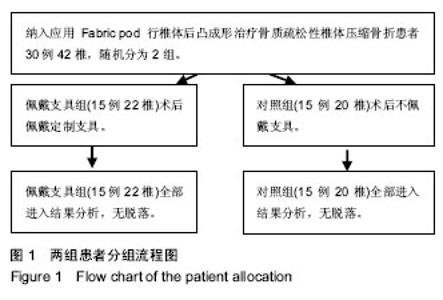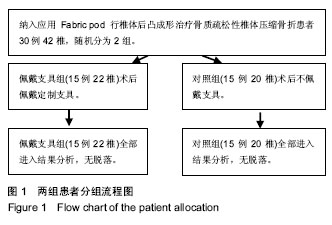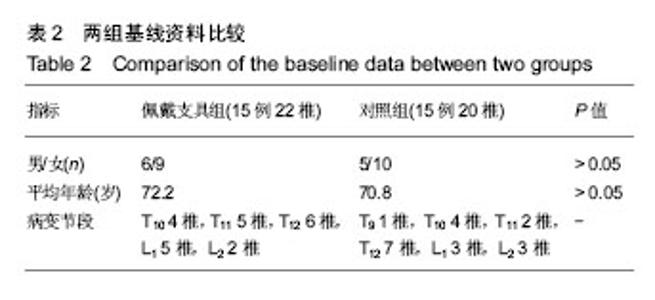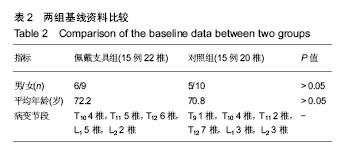Chinese Journal of Tissue Engineering Research ›› 2019, Vol. 23 ›› Issue (8): 1172-1176.doi: 10.3969/j.issn.2095-4344.1081
Previous Articles Next Articles
Application of thoracolumbar orthosis after fabric pod kyphoplasty for osteoporotic compression fracture
Qiang Hua, Chi Cheng, Wang Guodong, Yan Hui
- Department of Orthopedics, Beijing Tongren Hospital, Capital Medical University, Beijing 100730, China
-
Online:2019-03-18Published:2019-03-18 -
Contact:Yan Hui, Master, Attending physician, Department of Orthopedics, Beijing Tongren Hospital, Capital Medical University, Beijing 100730, China -
About author:Qiang Hua, MD, Associate chief physician, Department of Orthopedics, Beijing Tongren Hospital, Capital Medical University, Beijing 100730, China
CLC Number:
Cite this article
Qiang Hua, Chi Cheng, Wang Guodong, Yan Hui . Application of thoracolumbar orthosis after fabric pod kyphoplasty for osteoporotic compression fracture [J]. Chinese Journal of Tissue Engineering Research, 2019, 23(8): 1172-1176.
share this article
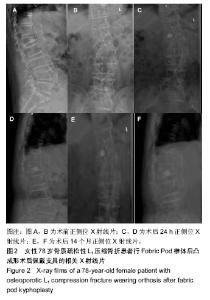
2组影像学复查显示,伤椎高度、Cobb角恢复满意,术后24 h及末次随访时与术前比较差异有显著性意义(P < 0.05),而术后2次随访间差异无显著性意义(P > 0.05)。 2.6 临床疗效分析 佩戴支具组患者在术后(7.0±2.8)d恢复到伤前活动水平,对照组患者在术后(14.0±4.8)d恢复到伤前活动水平,2组差异有显著性意义(P < 0.05)。随访期间佩戴支具组无相邻椎体压缩、无疼痛复发。对照组有4例患者出现相邻椎体压缩、疼痛复发。 2.7 典型病例 佩戴支具组患者,女,78岁,摔伤后胸背部疼痛,诊断为骨质疏松性L1压缩骨折,行Fobric pod椎体后凸成形术,相关影像学图片见图2。"

| [1] Marmor M, Alt V, Latta L,et al.Vertebral Augmentation for Osteoporotic Compression Fractures: Review of the FractureReduction Evaluation Trial.J Orthop Trauma. 2015;29 Suppl 12:S53-56.[2] Kim DH, Vaccaro AR.Osteoporotic compression fractures of the spine; current options and considerations for treatment.Spine J. 2006;6(5): 479-487.[3] Giele BM, Wiertsema SH, Beelen A, et,al. No evidence for the effectiveness of bracing in patients with thoracolumbar fractures. Acta Orthop. 2009;80(2):226-232.[4] 张建党,邹德威,马华松,等. 应用 Fabric pod 行椎体后凸成形术治疗骨质疏松性椎体骨折[J]. 中国脊柱脊髓杂志,2011,21(3):193-196.[5] Svedbom A, Alvares L, Cooper C, et al. Balloon kyphoplasty compared to vertebroplasty and nonsurgical management in patients hospitalised with acute osteoporotic vertebral compression fracture: a UK cost-effectiveness analysis. Osteoporos Int. 2013;24(1):355-367.[6] Buchbinder R, Johnston RV, Rischin KJ,et al.Percutaneous vertebroplasty for osteoporotic vertebral compression fracture.Cochrane Database Syst Rev. 2018;11:CD006349. [7] Yang W, Yang J, Liang M.Percutaneous vertebroplasty does not increase the incidence of new fractures in adjacent and nonadjacent vertebral bodies.Clin Spine Surg. 2018. [Epub ahead of print][8] Wang B, Zhao CP, Song LX,et al.Balloon kyphoplasty versus percutaneous vertebroplasty for osteoporotic vertebral compression fracture: a meta-analysis and systematic review.J Orthop Surg Res. 2018;13(1):264.[9] Patel A, Carter KR.Percutaneous vertebroplasty and kyphoplasty. Stat Pearls [Internet]. Treasure Island (FL): StatPearls Publishing, 2018.[10] Savage JW, Schroeder GD, Anderson PA.Vertebroplasty and kyphoplasty for the treatment of osteoporotic vertebral compression fractures.J Am Acad Orthop Surg. 2014;22(10):653-664.[11] Li HM, Zhang RJ, Gao H,et al. New vertebral fractures after osteoporotic vertebral compression fracture between balloonkyphoplasty and nonsurgical treatment PRISMA. Medicine (Baltimore). 2018;97(40):e12666.[12] Tan G, Li F, Zhou D,et al.Unilateral versus bilateral percutaneous balloon kyphoplasty for osteoporotic vertebral compression fractures: A systematic review of overlapping meta-analyses.Medicine (Baltimore). 2018;97(33):e11968.[13] Takahashi S, Hoshino M, Yasuda,H,et al.Cost-Effectiveness of Balloon Kyphoplasty for Patients with Acute/ Subacute Osteoporotic Vertebral Fractures in the Super-Aging Japanese Society.Spine (Phila Pa 1976). 2018. [Epub ahead of print][14] Bouza C, Lopez T, Magro A, et al. Efficacy and safety of balloon kyphoplasty in the treatment of vertebral compression fractures: a systematic review. Eur Spine J. 2006;15: 1050-1067. [15] Nussbaum DA, Gailloud P, Murphy K. A review of complications associated with vertebroplasty and kyphoplasty as reported to the Food and Drug Administration medical device related web site. J Vasc Interv Radiol. 2004;15:1185. [16] 张建党,马华松,邹德威,等.单侧椎弓根穿刺球囊扩张——椎体后凸成形术治疗骨质疏松性椎体压缩骨折并发骨水泥渗漏分析[J].颈腰痛杂志,2011, 32(5):263-265.[17] 张建党,马华松,邹德威,等.编织囊袋扩张椎体后凸成形术治疗周壁破损的骨质疏松性椎体压缩骨折[J].中国骨与关节损伤杂志,2012,27(1):23-25.[18] Chang V, Holly LT. Bracing for thoracolumbar fractures. Neurosurg Focus. 2014;37(1):E3. [19] Dai LD. Low lumbar spinal fractures: management options. Injury. 2002; 33: 579-582.[20] van der Roer N, de Lange ES, Bakker FC, et al. Management of traumatic thoracolumbar fractures: a systematic review of the literature. Eur Spine J. 2005; 14: 527-534.[21] Shamji MF, Roffey DM. A pilot evaluation of t-he role of bracing in stable thoracolumbar burst fractures without neurologic deficit. J Spinal Disord Tech. 2012. [Epub ahead of print][22] Bailey CS, Dvorak MF, Thomas KC, et al. Comparison of thoracolumbosacral orthosis and no orthosis for the treatment of thoracolumbar burst fractures:interim analysis of a multicenter randomized clinical equivalence trial. J Neurosurg Spine. 2009;11: 295-303. [23] Connolly PJ, Grob D. Bracing of patients after fusion for degenerative problems of the lumbar spine--yes or no? Spine. 1998; 23: 1426-1428. [24] Patwardhan AG, Li SP, Gavin T, et al. Orthotic stabilization of thoracolumbar injuries. A biomechanical analysis of the Jewett hyperextension orthosis. Spine. 1990; 15: 654-661.[25] Tropiano P, Huang RC, Louis CA, et al. Functional and radiographic outcome of thoracolumbar and lumbar burst fractures managed by closed orthopaedic reduction and casting. Spine. 2003; 28: 2459-2465. [26] Pfeifer M, Begerow B, Minne HW. Effects of a new spinal orthosis on posture, trunk strength, and quality of life in women with postmenopausal osteoporosis: a randomized trial. Am J Phys Med Rehabil. 2004; 83: 177-186.[27] Deyo RA, Tsui-Wu YJ. Descriptive epidemiology of low-back pain and its related medical care in the United States.Spine. 1987;12:264-268.[28] Savage JW, Schroeder GD, Anderson PA.Vertebroplasty and kyphoplasty for the treatment of osteoporotic vertebral compression fractures.J Am Acad Orthop Surg. 2014;22(10):653-664.[29] Shi C, Zhang M, Cheng AY, et al. Percutaneous kyphoplasty combined with zoledronic acid infusion in the treatment of osteoporotic thoracolumbar fractures in the elderly.Clin Interv Aging. 2018;13: 853-861. |
| [1] | An Yang, Liao Yinan, Xie Chengxin, Li Qinglong, Huang Ge, Jin Xin, Yin Dong. Mechanism of Inulae flos in the treatment of osteoporosis: an analysis based on network pharmacology [J]. Chinese Journal of Tissue Engineering Research, 2021, 25(在线): 1-8. |
| [2] | Zhang Tongtong, Wang Zhonghua, Wen Jie, Song Yuxin, Liu Lin. Application of three-dimensional printing model in surgical resection and reconstruction of cervical tumor [J]. Chinese Journal of Tissue Engineering Research, 2021, 25(9): 1335-1339. |
| [3] | Tang Hui, Yao Zhihao, Luo Daowen, Peng Shuanglin, Yang Shuanglin, Wang Lang, Xiao Jingang. High fat and high sugar diet combined with streptozotocin to establish a rat model of type 2 diabetic osteoporosis [J]. Chinese Journal of Tissue Engineering Research, 2021, 25(8): 1207-1211. |
| [4] | Li Zhongfeng, Chen Minghai, Fan Yinuo, Wei Qiushi, He Wei, Chen Zhenqiu. Mechanism of Yougui Yin for steroid-induced femoral head necrosis based on network pharmacology [J]. Chinese Journal of Tissue Engineering Research, 2021, 25(8): 1256-1263. |
| [5] | Zeng Yanhua, Hao Yanlei. In vitro culture and purification of Schwann cells: a systematic review [J]. Chinese Journal of Tissue Engineering Research, 2021, 25(7): 1135-1141. |
| [6] | Hou Guangyuan, Zhang Jixue, Zhang Zhijun, Meng Xianghui, Duan Wen, Gao Weilu. Bone cement pedicle screw fixation and fusion in the treatment of degenerative spinal disease with osteoporosis: one-year follow-up [J]. Chinese Journal of Tissue Engineering Research, 2021, 25(6): 878-883. |
| [7] | Liu Lihua, Sun Wei, Wang Yunting, Gao Fuqiang, Cheng Liming, Li Zirong, Wang Jiangning. Type L1 steroid-induced osteonecrosis of the femoral head through femoral head and neck junction decompression by fenestration: a single-center prospective clinical study [J]. Chinese Journal of Tissue Engineering Research, 2021, 25(6): 906-911. |
| [8] | Li Shibin, Lai Yu, Zhou Yi, Liao Jianzhao, Zhang Xiaoyun, Zhang Xuan. Pathogenesis of hormonal osteonecrosis of the femoral head and the target effect of related signaling pathways [J]. Chinese Journal of Tissue Engineering Research, 2021, 25(6): 935-941. |
| [9] | Xiao Fangjun, Chen Shudong, Luan Jiyao, Hou Yu, He Kun, Lin Dingkun. An insight into the mechanism of Salvia miltiorrhiza intervention on osteoporosis based on network pharmacology [J]. Chinese Journal of Tissue Engineering Research, 2021, 25(5): 772-778. |
| [10] | Liu Bo, Chen Xianghe, Yang Kang, Yu Huilin, Lu Pengcheng. Mechanism of DNA methylation in exercise intervention for osteoporosis [J]. Chinese Journal of Tissue Engineering Research, 2021, 25(5): 791-797. |
| [11] | Xu Dongzi, Zhang Ting, Ouyang Zhaolian. The global competitive situation of cardiac tissue engineering based on patent analysis [J]. Chinese Journal of Tissue Engineering Research, 2021, 25(5): 807-812. |
| [12] | Wu Zijian, Hu Zhaoduan, Xie Youqiong, Wang Feng, Li Jia, Li Bocun, Cai Guowei, Peng Rui. Three-dimensional printing technology and bone tissue engineering research: literature metrology and visual analysis of research hotspots [J]. Chinese Journal of Tissue Engineering Research, 2021, 25(4): 564-569. |
| [13] | Chang Wenliao, Zhao Jie, Sun Xiaoliang, Wang Kun, Wu Guofeng, Zhou Jian, Li Shuxiang, Sun Han. Material selection, theoretical design and biomimetic function of artificial periosteum [J]. Chinese Journal of Tissue Engineering Research, 2021, 25(4): 600-606. |
| [14] | Liu Fei, Cui Yutao, Liu He. Advantages and problems of local antibiotic delivery system in the treatment of osteomyelitis [J]. Chinese Journal of Tissue Engineering Research, 2021, 25(4): 614-620. |
| [15] | Li Xiaozhuang, Duan Hao, Wang Weizhou, Tang Zhihong, Wang Yanghao, He Fei. Application of bone tissue engineering materials in the treatment of bone defect diseases in vivo [J]. Chinese Journal of Tissue Engineering Research, 2021, 25(4): 626-631. |
| Viewed | ||||||
|
Full text |
|
|||||
|
Abstract |
|
|||||
